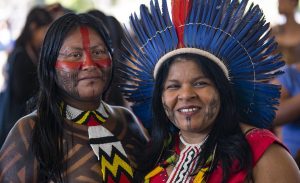The Kayapó tribe – this indigenous group calls the south-eastern Amazon Basin in Brazil their home, and they have been fighting for its protection for generations.
Located at the upper Xingu River, the tribal communities live in isolated villages scattered across the reserve, with under 100 to over 1000 inhabitants each, mostly just accessible by plane or river travel. Their diet consists of food obtained through hunting, fishing, gathering and horticulture. With help of the broad knowledge of their environment, they also developed seasonal short- and long-term market activities to participate in, making use of the resources at hand, such as Brazilian nut oil. Always striving to protect their territory, several Kayapó leaders and communities became more and more involved in the self-management of their reserve and found allies among NGOs to fight against threatening policies that include the destruction of the forest, resulting in a big media presence. Thereby, the Kayapó could continuously raise the awareness of the importance of their homeland and its conservation. Stretched across the states of Pará and Mato Grosso, the world-wide largest tropical protected area provides refuge to a vast biodiversity of many endangered and threatened plant and animal species. They cannot exist outside of this tract of tropical rainforest, which has approximately the size of Iceland and is situated in a highly de-forestated region. By fighting for its protection for decades, the Kayapó also defend the largest block of indigenous territory in Brazil and their officially owned lands.
Initiatives like the Kayapo Project support this territorial protection with surveillance management by establishing guard posts, as well as the further development of resource management and income generation activities within the communities. One research project focused on the possibilities of ecotourism within the Kayapó area as a sustainable source of income. A little number of student-tourists visited and took part in guided activities, while the whole project was under the control of the tribal community, so teachers from the village itself shared their knowledge etc. The outcomes showed that such ecotourism visits could bring benefits, if managed in a sustainable way. These ecotourism activities would provide
- additional revenue with less strain on the environment and the community
- the opportunity for the Kayapó to share knowledge about themselves and their territories in their own way
- a communicative experience in which they could become familiar with new languages and ideologies according to their interests
- expand their existing network of international support
This shows the importance of focusing on, involving, and giving the local communities a voice in new touristic developments of any kind!
Don’t hesitate to visit Kayapo.org for more information on the Kayapó Project! For more information on the ecotourism research, please find the article via the following link:
Zanotti, L., & Chernela, J. (2008). Conflicting Cultures of Nature: Ecotourism, Education and the Kayapó of the Brazilian Amazon. Tourism Geographies, 10(4), 495–521.





This Post Has 0 Comments